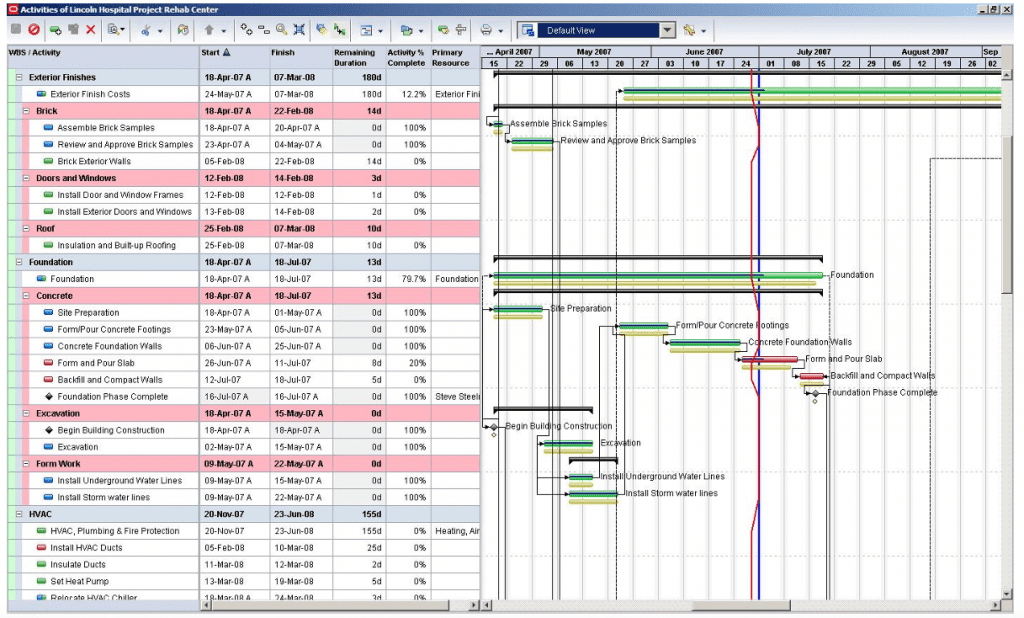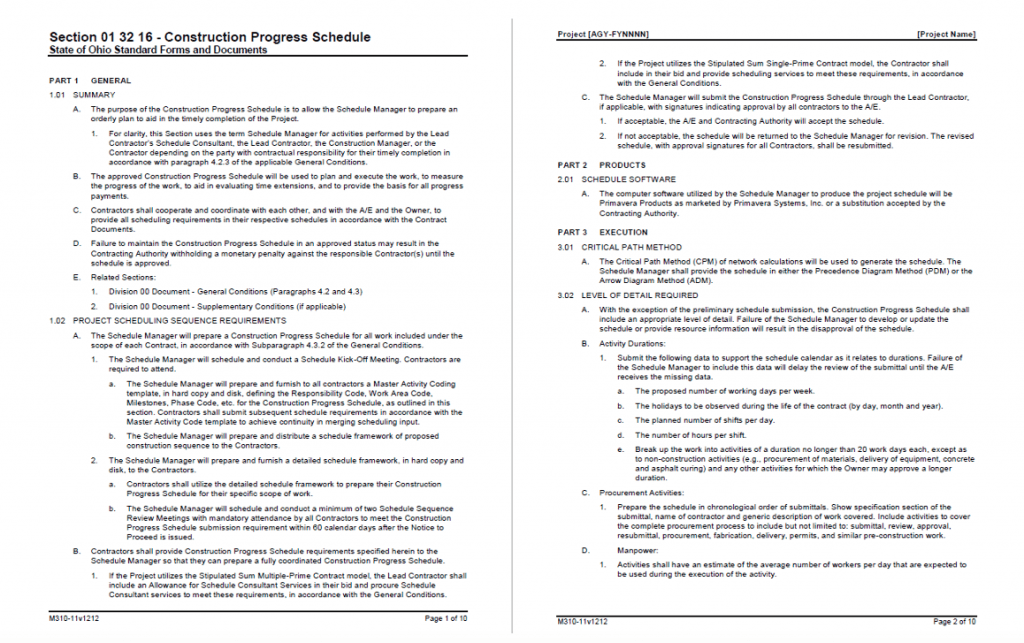The FIDIC 2017 edition made a significant expansion of the project schedule requirements that are part of clause 8, the primary clause which deals with time or “Commencement, Delays and Suspension”. The changes not only mandate the software to be used but also sets out that the contract schedule must include all (logically linked) activities and set out the sequence and timing of inspections and tests. In addition, all key dates must be identified, and all activities and milestones are to be logically linked, identifying float, rest days, and holidays as well as the delivery of materials. A supporting method statement is also a requirement.

Using a project management information system (PMIS) like PMWeb and planning software like Oracle Primavera P6 or MS Project can help all those entities involved in delivering projects under the FIDIC contract to fully comply as well as take advantage of the new schedule clauses. To start with, project owners must now expand the project schedule specifications to detail the requirements of having an integrated project schedule using the critical path method (CPM).

Having those detailed specifications enables the contractors to develop the project schedule work breakdown structure (WBS) levels and resource-loaded activities by the project’s requirements. To ensure compliance with sub-clause 1.1.67 the engineer needs to have a detailed checklist to formalize the review, analysis, and approval of the project’s schedule. FIDIC sub-clause 1.1.67 defines the schedule as meaning the detailed schedule prepared and submitted by the contractor to which the engineer has given, or is deemed to have given, a notice of no-objection. The checklist can be used for reviewing, analyzing, and approving baseline schedules, weekly or monthly updates, as well as revised schedules. Using the PMWeb custom form builder, a Schedule Review and Analysis form can be created as a predefined list of all items that need to be reviewed and analyzed before a project schedule is formally approved. The form includes different tables for which different project team members can be assigned to review and analyze. Those tables align with the workflow assigned to the schedule review form to ensure a formal and governed review, analysis, and approval process. A PDF version of the contractor’s project schedule and other relevant reports attachs to the schedule review form.

The new FIDIC revisions also emphasize how the project schedule can be used to manage all project activities including but not limited to mobilization, site access (sub-clause 8.3(i)), technical submittals review and approvals, procurement, permits, no-objection certificates, owner’s activities, construction activities, interface activities with other contractors, testing and commissioning, handover, and other on-site and off-site activities. Since most of those processes will be managed in a PMIS like PMWeb, both PMWeb and the tool used to create the project schedule, whether it was Oracle Primavera P6 or MS Project schedule must be aligned. PMWeb scheduling module allows importing the activities schedule information included in those schedules including the baseline, periodical updates, and revised versions.

Accordingly, for the submittal log that the contractor needs to submit along with the project’s baseline schedule, each submittal item must specify the project schedule activity that relates to each submittal item. This immediately provides the planned submission, review, and approval dates for this submittal item. PMWeb submittal items module allows having this feature as well as allows importing the complete submittal log along with the linked schedule activities from MS Excel.

The modified FIDIC edition also places an obligation on the contractor to update the project schedule to reflect actual progress. FIDIC clause 4.21 (Progress Reports) obliges the contractor to submit a comparison of actual and planned progress as part of the progress report. To ensure the correctness of the actual progress information, the daily progress report submitted by the contractor should detail all activities that have either started, progressed, or completed on that date. The report also links the actual deployed resources, labor, and non-labor, with their relevant project schedule activity. PMWeb daily report module allows capturing this information and assigning the relevant project schedule activity for each resource listed in the daily report. The daily report allows capturing the worked hours, and type of work performed among others needed for updating the project schedule.

Further, the FIDIC 2017 edition includes several clauses that promote the importance of dispute avoidance by keeping the project team members aware of the review and approval actions that could have an impact on the project schedule if they are delayed. For example, in the request for information form, it is highly recommended to link the RFI to the project schedule activity that could be impacted if the RFI is not closed before the activity scheduled start date.

Another time-sensitive project communication document is the meeting minutes for which, regardless of the purpose of the meeting, there will be actions assigned to the different project team members who must close before the agreed due date. Similar to the RFI, each meeting business item should be linked to the relevant project schedule activity. This immediately provides the project team members with an advanced warning on the impact that delayed actions could cause on the project.

In addition, the 2017 Red Book introduces warning provisions (sub-clause 8.4), which require each party to advise the other “in advance of any known or probable future events which may (a) adversely affect the work of the Contractor’s Personnel; (b) adversely affect the performance of the Works when completed; (c) increase the Contract Price; and/or (d) delay the execution of the Works or a Section (if any).” PMWeb custom form builder allows creating the early notification form capturing details of the event and the project schedule activity that could be impacted by this event.

Although the second edition of the FIDIC 2017 form has not set a mechanism for assessing requests for extension of time (EOT), nevertheless, it is highly recommended to have a process to encourage contractors to submit their EOTs with all details to enable the engineer to make a fair and reasonable determination by the terms of the contract and taking due regard of all relevant circumstances (FIDIC 2017 clause 3.7). The contractor uses the Extension of Time (EOT) request form to demonstrate his entitlement to the time extension. PMWeb custom form builder allows creating the form for capturing all EOT requests which include all needed fields and documents for the engineer to review and make a decision to either approve or reject.

In addition, the PMWeb custom form builder can be used to capture the Time Impact Analysis (TIA) details which provide the basis for the requested extension of time. The form details how the delay in the project’s completion date was established. The form also includes details if the delay caused by the employer was concurrent with a contractor delay, then the entitlement to an extension of time shall be assessed by the rules and procedures stated in the Special Provisions (Sub-clause 8.5 of the FIDIC Second Edition).

The new FIDIC 2017 also added the requirement for supplemental provisions if the contract provides an entitlement for payments against completed milestones which could be part of the contract. When a milestone is completed, it triggers an entitlement to payment. All such milestones should be clearly described by the employer and the contractor shall include all those milestones in the project schedule. The PMWeb progress invoice module allows linking each payment milestone with the relevant project schedule milestone activity to automatically capture the percent complete progress for each milestone from the updated project schedule.

The FIDIC new edition also added the precondition for the contractor to submit the monthly progress reports (sub-clause 4.20 (h)) which should include a comparison of planned and actual progress (sub-clause 14.3). By importing the updated project schedule into the PMWeb scheduling module, a report can be designed in the desired form and format to provide this schedule comparison requirement.

In conclusion, the FIDIC 2017 edition made a significant expansion to the project schedule requirements for which the project management team and in particular the planning engineers need to use a project management information system (PMIS) like PMWeb in addition to their planning software to fulfill those additional contract requirements as well as take advantages of integrating the project schedule with the everyday processes needed to manage the project and to help avoid disputes.



